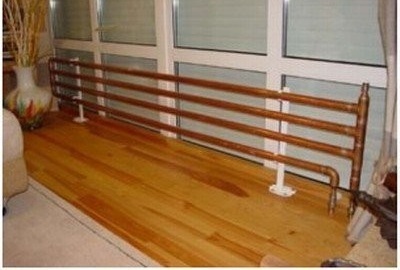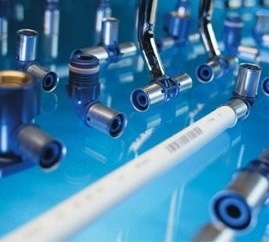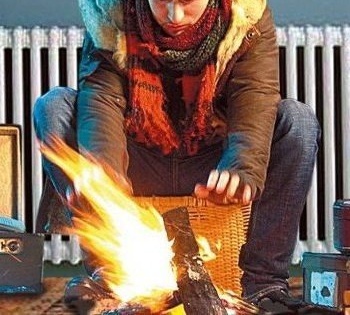Heating registers: designs, installation rules + overview of 2 home-made options

As heating devices, not only radiators can be used, but also factory and self-made heating registers. Previously, such heaters were installed most often in garages, warehouses, industrial shops and other commercial facilities. In order to reduce the cost of installation of autonomous heating systems, similar products began to be used in residential low-rise buildings. It is immediately worth noting that space heating with heating registers is less efficient compared to batteries. The latter benefit due to the larger heat transfer area formed by additional plates that are absent in the registers of the basic design. If desired, the owner of the object can eliminate this drawback by welding vertically oriented metal plates to round pipes. Otherwise, this problem is still solved by increasing the number of welded pipes of smaller diameter. Such a modification of the design of heating registers is resorted not only to increase the heat transfer of the device, but also to implement design ideas.
For the manufacture of heating registers, smooth-walled pipes of the same diameter and the same length are prepared. The diameter can range from 32 to 80 mm. Wider pipe products should not be used, because domestic boilers will not be able to provide a sufficient amount of heating medium to the heater. The registers will not be able to warm up well, which means they will not provide heat to the room in which they are installed.
Using gas welding or electric welding, these workpieces parallel to each other are welded together with smaller diameter pipes. According to these transverse tubes (pipes), the coolant circulating in the heating system of the house flows.
Content
Classic heating register designs
Option # 1 - horizontal register
Most often, in the manufacture of the heating register, two or three parallel pipes are laid, laid in the horizontal direction. The distance between adjacent sections in the register must necessarily be 50 mm larger than the diameter. The coil designs of registers are also popular, subdivided into several types depending on the method of connecting devices to the heating system.
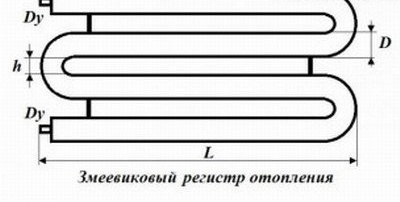
Coil type heating registers: L - length of the heater, D - pipe diameter, h - pipe distance (more than 50 mm in diameter)
The length of the heating devices is selected in accordance with the dimensions of the room or room in which it is planned to install the heating system. In addition to the listed types of designs of heating registers, there are also:
- single-tube products;
- four-pipe devices;
- five-tube models, etc.
The number of pipes used in one heating register depends on the area of the room to be heated, the quality of the object's insulation, the presence of other sources of heat in the room, etc. By sorting the possible pipe diameters, the optimal product sizes are calculated at which the optimum temperature regime will be maintained in the heated room.
Horizontal registers of heating from smooth pipes are used for lower piping. At the same time, the products are neatly placed around the perimeter of the room closer to the floor surface. In a residential building, pipes go under the windows. In industrial premises, the location of the heating devices depends on the height of the ceilings, the particular layout of the facility and the placement of industrial equipment.
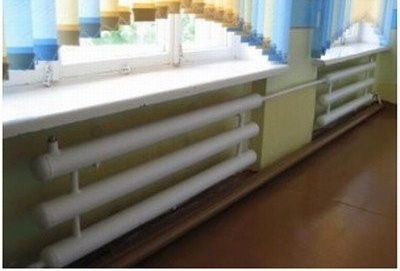
Heating registers successfully heat social facilities. Maintenance of such heating devices is much simpler than cast iron batteries.
Option # 2 - Vertical Registers
When redeveloping apartments and expanding their living space with balconies and loggias, it is necessary to dismantle the batteries installed by the developer upon delivery of the property. At the same time, dismantled radiators are replaced by vertical heating registers welded from a large number of round pipes of small diameter. These heaters are placed in a wall located next to the window opening.
If necessary, the vertical heating registers are closed with decorative grilles, which turn an obligatory element of the heating system into an interior decoration item. You can mask the location of the "bundle" of parallel pipes with the help of mirrors, colored glass, mosaics, wrought iron lattices, as well as by placing shelves, hangers, cabinets and other useful items of bulky furniture.
To ensure the movement of the coolant in a vertical register installed in an autonomous heating system of a private house, you can use a circulation pump. Horizontal registers are also used for natural circulation of the coolant, if their installation is carried out with a slight slope (0.05% is enough).
How many registers will it take to heat a house?
Pipes leading the coolant to the heating devices can also be considered registers to some extent. And the heated towel rail installed in each bathroom is also a kind of heating register. When calculating the exact number of heating registers necessary for comfortable heating of a room, a number of factors are considered that affect the amount of heat loss:
- the thickness of the bearing walls and the material of their manufacture;
- glazing area;
- Number of doors;
- thermal insulation of the floor and ceiling;
- orientation of the house to the cardinal points, etc.
A simplified calculation takes into account the heat transfer of one meter of pipe. For example, it has already been calculated that one linear meter of a 60 mm diameter pipe heats one square meter of living space (provided that the ceiling height is not more than 3 m).
If you buy ready-made heating registers instead of radiators, then you will not be able to achieve significant savings. It is possible to reduce financial costs only in the case of self-production of register-type heating appliances from materials purchased in bulk with discounts on the market. Welding work must also be done by hand. Otherwise, the cost of the services of a professional welder will block all the benefits from the wholesale purchase of pipes and fittings.
Mounting methods: welding or thread?
The biggest problem during installation work on the assembly and installation of heating registers is welding. Heating devices are assembled from individual parts outdoors, and then from the prepared blanks, the heating system is installed using gas welding. Welds can be replaced with threaded joints, which are inferior to them in strength and durability, but, subject to the technology of work and the use of modern materials, can ensure continuous operation of heating equipment.
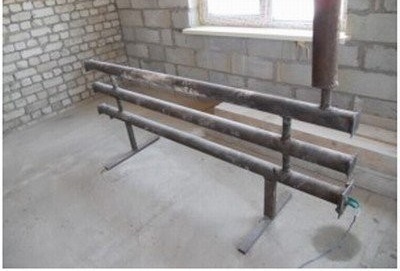
The heating register in a garage or warehouse is an independent device that allows you to heat a technical room with electricity
Homemade round tube registers
You can purchase home-made heating registers sold by professional welders on the market. If the finished products are not suitable for you in size, then the welders will produce heating appliances on an individual order. The quality of home-made products is not in doubt, so they are built into autonomous heating systems without fear and risk.
“Samovars” with heating elements are also popular with consumers. So called heating registers, which independently heat individual rooms due to electricity. Instead of water, oil, antifreeze or any other non-freezing liquid is poured into the pipes. Heating of the coolant is carried out by a conventional heating element, operating from a network with a voltage of 220 V. “Samovars” in their design resemble oil radiators produced in the factory. "Samovars" are used in extensions where it is impossible or inexpedient to build a water heating system. Heating devices operate in an autonomous mode, while their performance depends only on the availability of electricity.
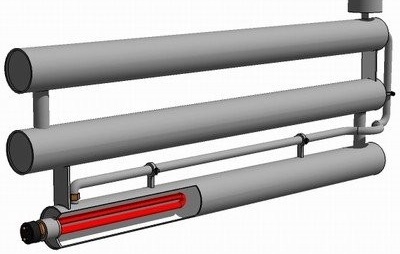
A samovar is one of the types of heating registers that are not connected to the home heating system, but heat one of the rooms with electricity
Homemade register from a profile pipe
To make a heating register from a profile pipe, a product of rectangular cross-section (60 by 80 mm) is chosen with its own hands, the wall thickness of which is 3 mm. A home-made heating battery (register) is assembled in several stages:
- first cut the pipe into several parts of a certain length;
- then, on the workpieces, markings are made for the holes into which the jumpers will be welded;
- make four jumpers from an inch round pipe (25 mm);
- plugs are cut from a 3 mm sheet of metal, the size of which is determined by the rectangular section of the profile;
- cut out holes for jumpers in the places of the marked markings, while in the upper and lower pipes of the register there should be two holes on one side, and in the middle pipe - four holes (two on both sides of the part);
- on wooden supports (timber) lay three pipes parallel to each other;
- Jumpers are inserted into the holes in the pipes, the parts are aligned according to the level, and each jumper pipe is gripped by electric welding in three places;
- after the product is turned from a horizontal position to a vertical position;
- begin to boil all the tacked jumpers in two seams, adjusting the strength of the welding current, to prevent the formation of places of possible leaks;
- after the profile pipes are cleaned of slag and metal debris that has fallen into the cavity of the product;
- pre-assembled stubs are applied to the ends of the profile pipes, they are gripped diagonally, and then they are thoroughly boiled along the entire perimeter of the rectangular section of the profile;
- grinder lightly grill the cooking seams throughout the heating register;
- in the upper pipe of a self-made register a hole is cut out under the Mayevsky crane;
- the register can be connected to the heating system from below, from the side, from above, or by a combination of the above options (from below and above, diagonally, etc.):
- the outlet opening is closed with a plug, the register is filled with water, after which the master looks through all the welded joints, eliminating the possibility of leakage through microcracks;
- weld floor supports from steel corners or brackets that allow you to mount the device on the wall.
Such a register has high heat transfer due to the large amount of coolant flowing through the profile pipes. Jumpers should be located as close as possible to the end edges of horizontal parts. The coolant is supplied through the inlet pipe located in the upper pipe. After passing all the elements of the device, the coolant flows through the outlet pipe located on the lower pipe.
As you can see, it’s not difficult to make a heating register with your own hands if you have a welding machine and experience with it. Home-made heating appliances can be welded in exact accordance with the dimensions of the heated room. To buy a ready-made heating register, you will have to prepare three times more money than to purchase all the necessary materials for self-welding of the product. To ensure long-term operation of the device, pipes made of carbon steel, stainless low-alloy steel or cast iron are purchased.
